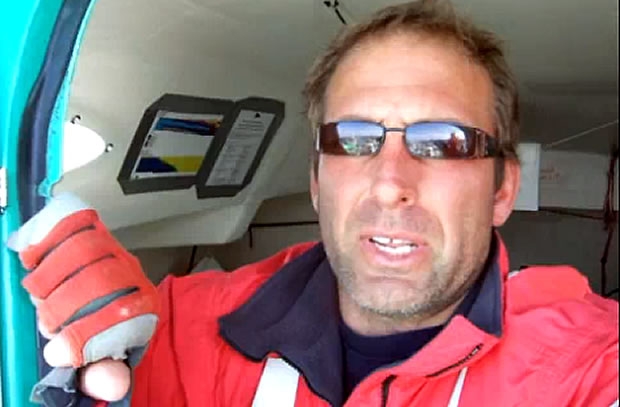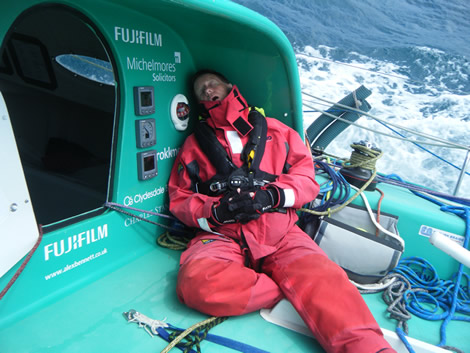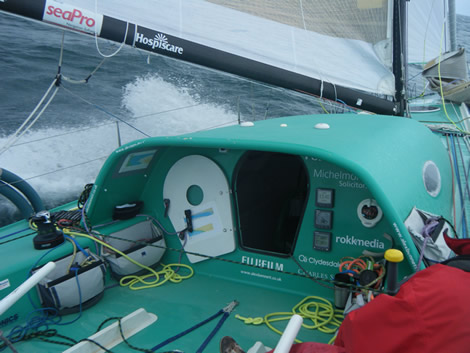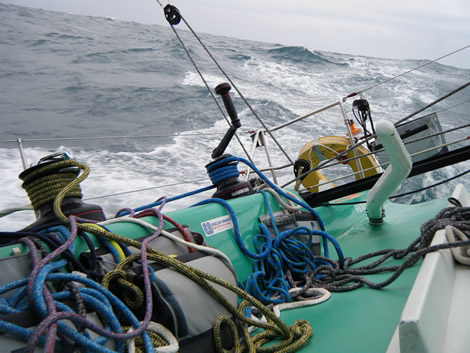46 knots in the North Sea
One of the most experienced shorthanded ocean racers competing in the Shetlands Round Britain and Ireland Race is Alex Bennett, competing aboard his Owen-Clarke designed Class 40 Fujifilm with co-skipper Malcolm Dickinson.
But even for Bennett, who sailed around the world in the Oryx Quest, competed in the Mini Transat and the Transat Jacques Vabre, and was also one of Pete Goss’ crew on the Team Phillips maxi-cat, leg four of the Royal Western YC’s doublehanded lap of the British isles was a little too full-on.

Fujifilm at the start - photo: Tom Gruitt
Fujifilm pulled into the lead among the Class 40 on the previous leg up to Lerwick but approaching the finish she was pipped to the post by the wily Paul Peggs and Marco Nannini on the latter’s Sungard Front Arena. As Bennett explains: “Literally up to a mile from the finish line at Lerwick, the breeze just shut off and Sungard was behind us by a mile and a half and managed just to carry the old breeze right up to where we were, but headed further inshore because they saw we’d stopped and they just got the lightest of zephyrs to pull them along the cliffs and then they parked in front of us. About an hour later the breeze filled in from ahead and they just got it and that let them through to the finish in first. So a bit stressful and a bit annoying, but that’s yacht racing at the end of the day. We were only separated by 20 minutes there, so it wasn’t a big deal.”
While the leg up to the Shetlands had been relatively light, leg four from Lerwick down the North Sea to Lowestoft in Suffolk, was anything but. This was particularly the case for boats like Fujifilm that had chosen a more easterly route south. As Bennett explains: “We were considering doing it in one or two gybes, so we sailed out to the east on port gybe from Lerwick and sailed pretty much half way down the North Sea, before we gybed in. The only downside was that in the east there were much steeper waves - which we knew would be the case - and the wind would be that bit stronger. We saw a maximum of 48 knots of wind and a sustained wind of about 40. It was from behind, but because that northerly set had been running for so long the sea state was truly monumental - it was huge and its period was very very steep and high and tightly packed. What that meant was that the boat would surf down a wave, but there wasn’t enough time for it to fully surf out of it, so that made the going horrendous and pretty tough.”
A rogue got personal with Bennett. As he describes: “One wave hit us on our starboard quarter, after we’d done our first gybe. At that stage we were running with three reefs and a scrap of jib up and it literally just washed me out of the cockpit to the limit of my lifeline on the leeward side. My lifeline was clipped to the high side of the boat and the wave broke over the top of my head – I didn’t even see it coming. Malcolm was down below. It laid the boat over on its side - for a split second I though the boat as going to be completely rolled over but it quickly found its stability. I was washed across to the other side lifelines which were now in the water in a sea of foam and white water. It was a little bit scary for a minute or two until I managed to sort myself out and I felt the lifeline take up which stopped me from going fully over the side. But we quickly got the boat back on her feet and sailing fast again. If I hadn’t been wearing my lifeline God knows what would have happened.”
Bennett injured his knee in the process, but he was not alone. On Saturday night at the height of the severe gale, both Bennett and Dickinson were down below when the boat threw itself off a wave, causing Dickinson to take a fall. “He cut his forehead open on one of the ballast crossover pipes,” recounts Bennett. “He looked at me and said ‘I think I’ve bumped my head’ and all of a sudden there was claret coming out of it everywhere. So that was a medical emergency but he wasn’t having double vision. I put some gauze on his head and cut away some of his hair to get to the wound. It was superficial.”
As to why they had gone east Bennett says that it was because there would be more wind but principally because it would be a better angle to lay Lowestoft. “One of the things I didn’t fancy doing in that wind and sea state was a lot of gybing and the other option to go west, which is what Sungard did, you’d end up doing a lot of gybes to get to Lowestoft. I thought that would be lending itself to more breakage every time you gybed. As it happened out in the east during the height of the storm we had the mainsail down on the deck for 12 hours just surviving – we had stopped racing, although still pointing in the right direction and still going very fast, but we were just hanging in there - I started to wonder whether we had overcooked it and whether we should have gone further west.”
In fact Bennett points out that while leg four saw them lose two hours to the Shetland Round Britain & Ireland Race leaders on Sungard Front Arena, he has also extended a little on the Class 40s behind them, who all had their own issues. “Paul and Marco sailed a very good race and deserved the victory. Tactically maybe the right thing to do would have been to go to the west looking at it in hindsight, but the difference between the two choices was not that great. It translated into an easier ride in the west and a more extreme experience in the east. But I thoroughly enjoyed a challenging and pretty heavy going leg.”
While Fujfilm’s crew may have bumps and bruises, Bennett says the boat has been superb. “We hit 26 knots down the face of a wave which was pretty full on! On a boat like Fuji in those conditions with those short seas just steering the boat down the face of a wave at that speed with white water everywhere, was pretty difficult. I couldn’t even see through the spray and it was hard to place the bow of the boat in the waves as it went down at that speed. It was literally thrown down the waves so hard that before it hit the bottom of the trough it bounced.
“26 knots was a new record for me on a small monohull like Fuji. We did 24 in the Transat. We had several surfs of 22-23 where it was quite comfortable and throughout the boat has always felt nothing but solid and safe and very capable - a testament to the Owen Clarke design. She is a very fast but very safe boat and throughout the whole period I never felt unsafe at all, although the size of those waves was quite epic. Marco checked the wave heights when they got in and worked out that they were about 8m - and that was where they were. In the east the wave height was definitely bigger. They were pretty intimidating.”
Bennett is now looking forward to the final leg which after a mandatory 48 hour stopover in Lowestoft will begin tonight for Fujifilm. In theory their Owen Clarke design should be more slippery than Nannini and Peggs’ Akilaria Class 40 in the light.
“The last leg looks like it is going to be a light wind affair, if not a drifter, with very very light southerly winds as this high pressure moves across us. I think anyone with a few hours on another boat will be pleased that they have got it, because they are going to need it. So I think I am quite happy with light airs as long as it doesn’t turn fickle and into a lottery.” Fuji has already shown her light wind potential on the leg up to Lerwick, Bennett says.
The only problem with this final leg is that there is a lot of keeping the coast to starboard and tactical options are limited. “You have the Dover Straits, coming across the Thames Estuary, the offshore windfarms off North Foreland and they are all marks of the course you have to navigate around and they limit your tactical decisions, so I think it is going to be a case of a little bit of luck with the boat and a shed load of concentration and commitment to just keep the boat moving when it goes really light. Either way I think it will be a very close run race at the finish, and I wouldn’t be surprised if you didn’t see sevcn of us coming across in a procession within minutes of each other.”
The first finishers should be into Plymouth on Friday or Saturday, depending upon just how light conditions are.
See on board video from Fujifilm here















Latest Comments
Add a comment - Members log in